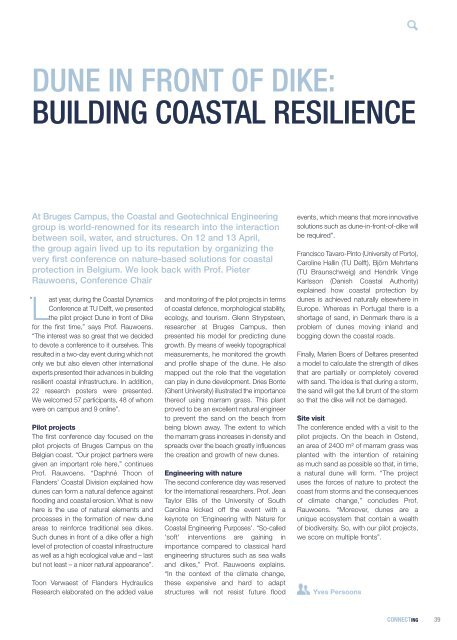ConnectING 19 juni 2022
You also want an ePaper? Increase the reach of your titles
YUMPU automatically turns print PDFs into web optimized ePapers that Google loves.
DUNE IN FRONT OF DIKE:<br />
BUILDING COASTAL RESILIENCE<br />
At Bruges Campus, the Coastal and Geotechnical Engineering<br />
group is world-renowned for its research into the interaction<br />
between soil, water, and structures. On 12 and 13 April,<br />
the group again lived up to its reputation by organizing the<br />
very first conference on nature-based solutions for coastal<br />
protection in Belgium. We look back with Prof. Pieter<br />
Rauwoens, Conference Chair<br />
“ Last year, during the Coastal Dynamics<br />
Conference at TU Delft, we presented<br />
the pilot project Dune in front of Dike<br />
for the first time,” says Prof. Rauwoens.<br />
“The interest was so great that we decided<br />
to devote a conference to it ourselves. This<br />
resulted in a two-day event during which not<br />
only we but also eleven other international<br />
experts presented their advances in building<br />
resilient coastal infrastructure. In addition,<br />
22 research posters were presented.<br />
We welcomed 57 participants, 48 of whom<br />
were on campus and 9 online”.<br />
Pilot projects<br />
The first conference day focused on the<br />
pilot projects of Bruges Campus on the<br />
Belgian coast. “Our project partners were<br />
given an important role here,” continues<br />
Prof. Rauwoens. “Daphné Thoon of<br />
Flanders’ Coastal Division explained how<br />
dunes can form a natural defence against<br />
flooding and coastal erosion. What is new<br />
here is the use of natural elements and<br />
processes in the formation of new dune<br />
areas to reinforce traditional sea dikes.<br />
Such dunes in front of a dike offer a high<br />
level of protection of coastal infrastructure<br />
as well as a high ecological value and – last<br />
but not least – a nicer natural appearance”.<br />
Toon Verwaest of Flanders Hydraulics<br />
Research elaborated on the added value<br />
and monitoring of the pilot projects in terms<br />
of coastal defence, morphological stability,<br />
ecology, and tourism. Glenn Strypsteen,<br />
researcher at Bruges Campus, then<br />
presented his model for predicting dune<br />
growth. By means of weekly topographical<br />
measurements, he monitored the growth<br />
and profile shape of the dune. He also<br />
mapped out the role that the vegetation<br />
can play in dune development. Dries Bonte<br />
(Ghent University) illustrated the importance<br />
thereof using marram grass. This plant<br />
proved to be an excellent natural engineer<br />
to prevent the sand on the beach from<br />
being blown away. The extent to which<br />
the marram grass increases in density and<br />
spreads over the beach greatly influences<br />
the creation and growth of new dunes.<br />
Engineering with nature<br />
The second conference day was reserved<br />
for the international researchers. Prof. Jean<br />
Taylor Ellis of the University of South<br />
Carolina kicked off the event with a<br />
keynote on 'Engineering with Nature for<br />
Coastal Engineering Purposes'. “So-called<br />
'soft' interventions are gaining in<br />
importance compared to classical hard<br />
engineering structures such as sea walls<br />
and dikes,” Prof. Rauwoens explains.<br />
“In the context of the climate change,<br />
these expensive and hard to adapt<br />
structures will not resist future flood<br />
events, which means that more innovative<br />
solutions such as dune-in-front-of-dike will<br />
be required”.<br />
Francisco Tavaro-Pinto (University of Porto),<br />
Caroline Hallin (TU Delft), Björn Mehrtens<br />
(TU Braunschweig) and Hendrik Vinge<br />
Karlsson (Danish Coastal Authority)<br />
explained how coastal protection by<br />
dunes is achieved naturally elsewhere in<br />
Europe. Whereas in Portugal there is a<br />
shortage of sand, in Denmark there is a<br />
problem of dunes moving inland and<br />
bogging down the coastal roads.<br />
Finally, Marien Boers of Deltares presented<br />
a model to calculate the strength of dikes<br />
that are partially or completely covered<br />
with sand. The idea is that during a storm,<br />
the sand will get the full brunt of the storm<br />
so that the dike will not be damaged.<br />
Site visit<br />
The conference ended with a visit to the<br />
pilot projects. On the beach in Ostend,<br />
an area of 2400 m² of marram grass was<br />
planted with the intention of retaining<br />
as much sand as possible so that, in time,<br />
a natural dune will form. “The project<br />
uses the forces of nature to protect the<br />
coast from storms and the consequences<br />
of climate change,” concludes Prof.<br />
Rauwoens. “Moreover, dunes are a<br />
unique ecosystem that contain a wealth<br />
of biodiversity. So, with our pilot projects,<br />
we score on multiple fronts”.<br />
Yves Persoons<br />
CONNECTING<br />
39














